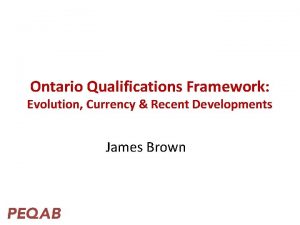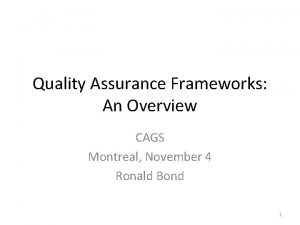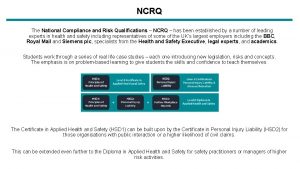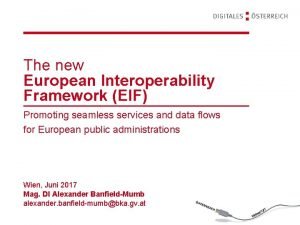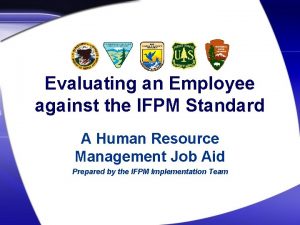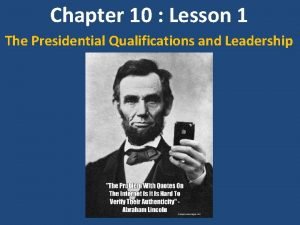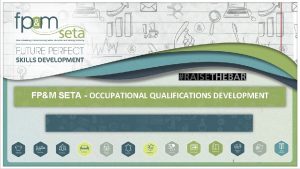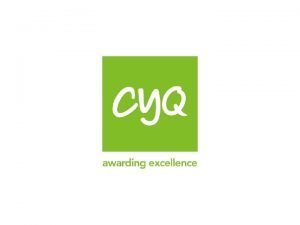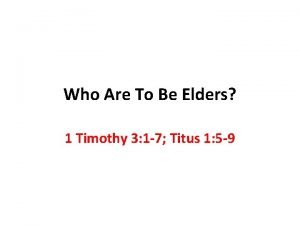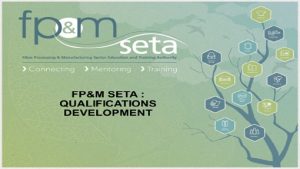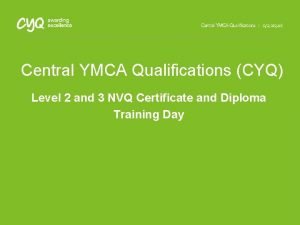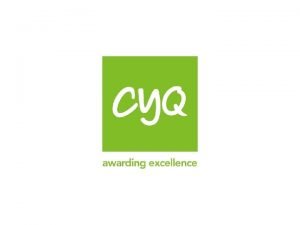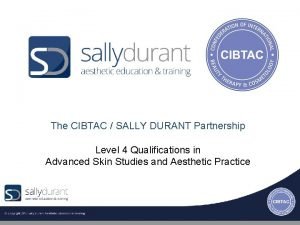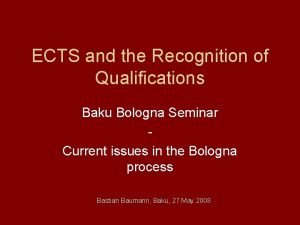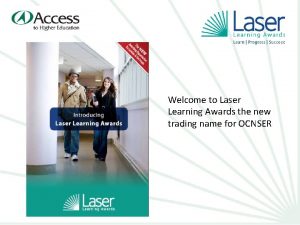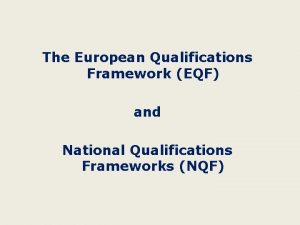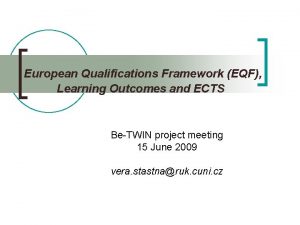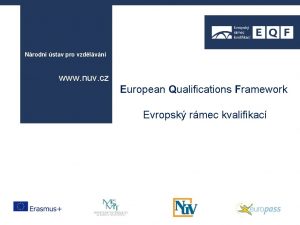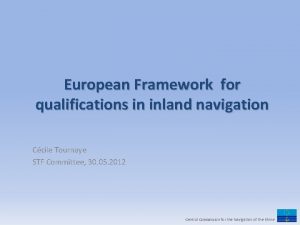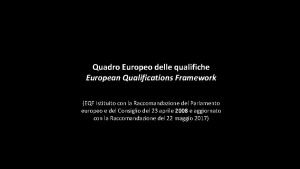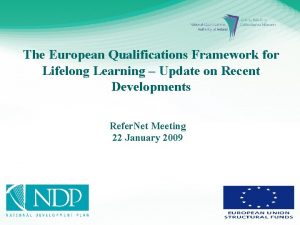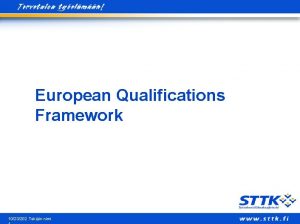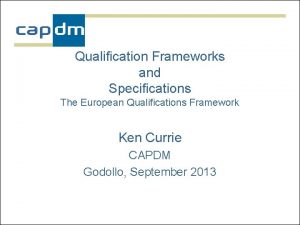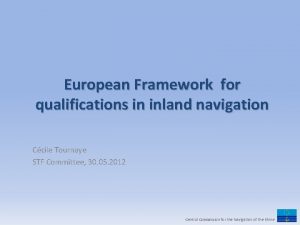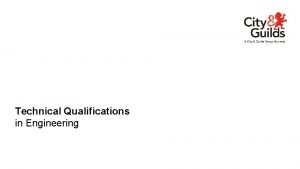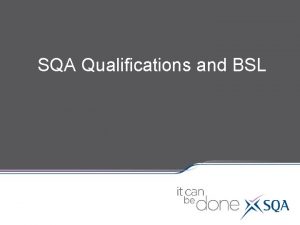From the European Qualifications Framework to the National









































- Slides: 41

From the European Qualifications Framework to the National Qualifications Frameworks: The Portuguese Approach for the Recognition, Validation and Certification of Competences UNESCO, Bangkok June 2013 Susana Oliveira, Kerigma, Portugal

The EQF Launched by the European Commission September 2006 Deadline for implementation on the national level extended until 2015 Voluntary process

Some remarks about the EQF: „ A translation Device based on Learning Outcomes“ Why do we need it? To promote geographical and labour market mobility To promote Lifelong Learning To foster cooperation between the stakeholders within the education sector & between the education sector and the world of work To foster reform sin the education systems

Remarks (II) • • How does it work? „Framework of Frameworks“ Neutral reference point for national qualifications Not to harmonize systems, but to make them comparable Based on a set of outcome descriptors Simple and generic Approximination of descriptors to make qualifications comparable

How does it work? II Horizontal and vertical reading • „Read the whole line“ (all descirptors to be filled) • „Ladder Model“ with increasing • Complexity and depth of knowledge • Degree of independence • Range of application … and here it is:

Titel Textmasterformate www. eaea. org www. dvv-international. de

From the EQF to the Portuguese NQS

O Sistema Nacional de Qualificações The NQS – The portuguese case To recover ASAP from an heavy delay… • More than 485 thousand youngsters with ages between 18 & 24 are working without secondary education (more than 260 thousand have not concluded compulsoy school); • 3, 5 million active adults have less than secondary educations; • 2, 5 million active adults do not have the compulsory school level – together about 60% of active population • Only 20% had secondary education - average OECD countries is 70%;

O Sistema Nacional de Qualificações The NQS – The portuguese case Three main strategies: • To improve the access to education by meeting all those who need new learning opportunities and recognition of competences; • To develop a system where all non formal education strategies or formal training courses have a value and contribute to education progression ; • To increase the relevance of adult education for economy modernization – or we risked to loose funding – developing the capacity for producing qualoification and critical competences for competitiveness but also - or in first place – for personal and social development;

O Sistema Nacional de Qualificações The NQS – The portuguese case The NQS • Was discussed and adopts theprinciples agreed with social partners; • Integrates the New Opportunities Initiative’s aims and creates the New Opportunities Centers • Reformulates VET and CVET, by compiling everything in one system; • Guarantees articulation with funding (mainly ESF)

Trainers, Teachers’ qualifications Professional Guidance Public Funding Training Providers Certification Quality National Catalogue for Qualifications TOOLS NQF Structures New Opportunities’ Centers Validation of competences Training Providers NQF Coordination National Agency for Qualification - ANQEP Individual Competence’s Passport

O Sistema Nacional de Qualificações The Portuguese NQS- AIMs • Secondary Education as minimum pathway of education; • To improve flexibility in CVET for adult population and validate & certify acquired competences; • To structure VET & CVET, correctly adapted to the market job needs – New skills for new jobs – based on emerging needs from companies and social sector; • To promote coherence, transparence and matching qualifications, at a national and international/ european level;

O Sistema Nacional de Qualificações The NQS tools: • The National Catalogue for Qualifications (CNQ) • The Individual Passport for Competences • The NQF

O Sistema Nacional de Qualificações The National Catalogue for Qualifications: It’s a dynamic tool for strategical management of qualifications (excluding higher education) that aims to promote: • The access to qualification, mainly for adults with low level of qualification; • It improves the flexibility of the standards, once it offers training modules of 25 h or 50 h, independently certtified and which can contribute to one or more qiuaoloification; • It offers the possibility of Recognition, Validation and Certification of competences developed in different contexts;

O Sistema Nacional de Qualificações The National Catalogue for Qualifications Available on… www. catalogo. anq. gov. pt

O Sistema Nacional de Qualificações The National Catalogue for Qualifications It defines for each qualification… Professional Profile • Mission • Activities • Competences - Knowledges - Soft skills Standards for VET or CVET • Profile after the course • Standards Organisation: - Schoolar training - Technological training • Workplacement • Development of training modules • Pedaghogical resources suggestions Standards for RPL Schoolar • Competence units Units • Evidence Criteria Nowadays, it includes… 274 qualifications… in 39 Educational areas Technological (Professional)

O Sistema Nacional de Qualificações The National Catalogue for Qualifications The CNQ standards… Are exclusively used in Adult Education and Training courses Recognition of Prior Learning/ Recognition, Validation and Certification of competences Certification: • Qualification Certificate • Diploma • It is thought as qualifications based on Competences, which guarantees articulation with the EQF and with the ECVET – European Credit System for VET – learning outcomes are centralised and lifelong learning promotion and value is guaranteed;

O Sistema Nacional de Qualificações The Portuguese NQF Tools: NQF Tools… • The National Qualification’s Catalogue - CNQ • The Individual Passport of Competences • The EQF

The Individual Passport of Competences It allows the registration of… • All competences and training modules/ courses acquired by the adult during his life and which are identyfied in the CNQ; • Other non formal learing activities which are not previewed in te CNQ; Some advantages… • It allows to each adult to communicate effectively his lifelong learning activities and competences acquired and validated; • It allows to the employers to better understand the match between their demand the candidate supply; • It allows to the owner to better organize his lifelong learning pathway, identifying strenghs and weaknesses;

New Opportunities Centers (CNO): Mission, Constitution and Reference patterns Recognition, Validation & Certification of Competences

New Opportunities Centers – CNO Recognition, Validation and Certification of Formal, non Formal and Informal Competences Management… • Managed by ANQEP – National Agency for Qualification; ANQEP authorises the creation & implementation of the centers, by considering the needs of the population at a local or regional level; • ANQEP monitores and evaluates the New Opportunities Centers – CNO – functioning ; • Defines the ESF allocation of costs;

New Opportunities Centers – CNO Recognition, Validation and Certification of Formal, non Formal and Informal Competences For whom? • All adults with 18 years old or more; • Without qualification or with low, insufficient or mismatched qualifications for his personal or professional needs; • Who have not completed levels, 1, 2, 3 or 4 of qualification;

New Opportunities Centers – CNO Recognition, Validation and Certification of Formal, non Formal and Informal Competences What do they do? • Tutoring and guidance for CVET routes; • Recognition, Validation and Certification of Competences acquired in all contexts of life: - For obtaining a different / superior level of qualification; - To allow the adult to understand whereas in what concerns qualification levels he is positioned;

New Opportunities Centers – CNO Recognition, Validation and Certification of Formal, non Formal and Informal Competences Which institutions can be a New Opportunities Center? • Public or private institutions, such as : üSchools; üTraining Providers; üMunicipalities; üLocal Development Associations; üCompanies; • What makes the difference? - its influence area, ; its domiain of intervention; target publics;

New Opportunities Centers – CNO Recognition, Validation and Certification of Formal, non Formal and Informal Competences The Team… • Director (1); • Coordinator (1); • Guidance staff (1); • Tutors (5); • Assessors (at least 5); • Administrative staff (2)

New Opportunities Centers – CNO Recognition, Validation and Certification of Formal, non Formal and Informal Competences The Quality Commitment contains: • The Mission and principles; • The phases/ steps for intervention; • The quality reference patterns

New Opportunities Centers – CNO Recognition, Validation and Certification of Formal, non Formal and Informal Competences The Mission: • To give a flexible and individualized answer to all adult citizens; • To promote the motivation for looking for new formal or non formal learning activities; • To ensure the quality and relevance of the investments made by each adult in his own lifelong learning route, by giving social value to the acquired competences;

New Opportunities Centers – CNO Recognition, Validation and Certification of Formal, non Formal and Informal Competences Principles: • Flexibility… • Confidentiallity… • Quality and Efficience… • Responsibility and Autonomy. . .

New Opportunities Centers – CNO Recognition, Validation and Certification of Formal, non Formal and Informal Competences Steps/ phases for intervention… • Registration • Diagnosys • Guidance (for the center (RVCC) or for a training route) • Recognition of competences • Validation of competences • Certification of competences

CNO – Step by step… A B C Other CVET Certification by the VET Provider • Registration • Diagnosys • Guidance Partial Certification Total Certification (by the juri in the CNO) D. RVCC Process E. Personal Development Plan

The Methodology… “… my life was full of images without any link. Now i’m building the puzzle…” It is a system that feeds itself from Life!!!

The Methodology… The harmony and complementarity between the “Bilan des compétences” & Biography; The Bilan des compétences works like a GPS that helps us to find our life expriences in our memories. It gives us a code for reading and interpreting those life experiences; The Biography works like the instructions book for solving “the puzzle” of life experiences;

New Opportunities Centers – CNO Recognition, Validation and Certification of Formal, non Formal and Informal Competences The Network evolution: 500 450 400 350 300 250 459 456 2008 2009 200 150 270 269 2006 2007 100 50 6 0 2000 98 28 42 56 73 2001 2002 2003 2004 2005 Iniciativa Novas Oprtunidades Centros RVCC Centros Novas Oprtunidades

Centros Novas Oportunidades: Missão, Constituição e Padrões de Referência New Opportunities Centers – CNO Recognition, Validation and Certification of Formal, non Formal and Informal Competences The network, considering the type of promoter… 1% 2% 3% 7% 4% Escolas públicas 5% 44% Centros de Formação Profissional Escolas Profissionais 6% Associações Empresariais Associações Locais 9% Empresas de Formação Instituições de Solidariedade Social 19% Autarquias ou Empresas Municipais Empresas Privadas Outros

Looking into Europe. . Lifelong Learning Programme as support to develop new methods and share practices around Europe: Exs. Grundtvig, Leonardo da Vinci sectoral programmes AMa. P – Age Management in Practice

AMa. P – Age Management in Practice The Age Management in Practice (AMa. P) project is a collaborative partnership involving organisations from ü ü Germany; ü Greece; ü Poland; AMa. P aims to address the challenge around access to, and participation in, Continuing Vocational Education and Training (CVET) among older workers aged 50+, and to increase awareness of the European Qualification Framework (EQF). The project also considers the challenge of an ageing ü Portugal; workforce through the lens of employers, seeking current ü Sweden; views and attitudes towards older workers and promotes the UK (coordinator) implementation of age management practices.

AMa. P’s aims and objectives: Improve access to CVET for older workers by identifying challenges and supporting participation in lifelong learning Outcomes: a) AMa. P Learning Model Develop a learner engagement model for older workers aged 50+

AMa. P’s aims and objectives: To raise awareness and give visibility to EQF in European Countries Develop a mapping system that allows each adult to focus on their position and redefine lifelong learning plans

AMa. P Mapping System

AMa. P’s aims and objectives: Investigate and positively influence attitudes of employers towards older workers www. a-map. eu Conduct an employer’s survey to measure awareness of the ageing workforce and attitudes towards older workers Organise seminars for employers on age management and create a DVD of employer views

Thank You! Susana Oliveira susanaoliveira@kerigma. pt
 Eqf lll
Eqf lll What is nqf
What is nqf Ontario qualifications framework level 12
Ontario qualifications framework level 12 Ontario qualifications framework
Ontario qualifications framework Ncrq diploma assignments
Ncrq diploma assignments Eif modellen
Eif modellen Informal qualifications for president
Informal qualifications for president Cno qualifications
Cno qualifications Lisa collett
Lisa collett Insure oklahoma qualifications
Insure oklahoma qualifications Skills vs qualifications
Skills vs qualifications Ifpm qualifications
Ifpm qualifications How to write a short account
How to write a short account Lesson 1 presidential qualifications and leadership
Lesson 1 presidential qualifications and leadership Cao qualifications & assessment summary
Cao qualifications & assessment summary What is shadow teaching
What is shadow teaching Indicium
Indicium Excelsior scholarship qualifications
Excelsior scholarship qualifications Cyq qualifications
Cyq qualifications Qualifications for elders 1 timothy
Qualifications for elders 1 timothy Radiation protection officer qualifications
Radiation protection officer qualifications Qualifications evaluation council of ontario
Qualifications evaluation council of ontario Qeco evaluation chart
Qeco evaluation chart Fp&m seta qualifications
Fp&m seta qualifications Seta ready content development
Seta ready content development President formal and informal powers
President formal and informal powers Cyq
Cyq Cyq level 2
Cyq level 2 Jimmy manyi wikipedia
Jimmy manyi wikipedia Cibtac level 4
Cibtac level 4 How to become a family support worker in ireland
How to become a family support worker in ireland Rowan atkinson qualifications
Rowan atkinson qualifications Transforming moments by gcina
Transforming moments by gcina Idta teaching qualifications
Idta teaching qualifications Qualifications baku
Qualifications baku Laser access to he
Laser access to he Death by a thousand qualifications fallacy
Death by a thousand qualifications fallacy Ability one program
Ability one program Dispositional framework vs regulatory framework
Dispositional framework vs regulatory framework Theoretical framework in research example
Theoretical framework in research example Theoretical framework vs conceptual framework
Theoretical framework vs conceptual framework Conceptual framework theoretical framework
Conceptual framework theoretical framework


